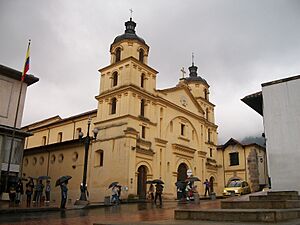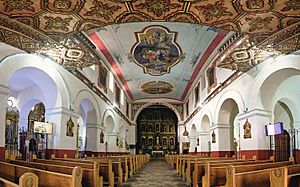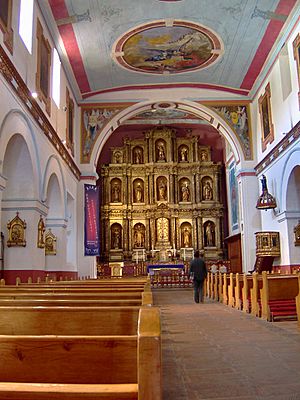Church of Nuestra Señora de la Candelaria, Bogotá facts for kids
The Church of Nuestra Señora de la Candelaria, also known as the Iglesia de la Candelaria, is a Catholic church in Bogotá, Colombia. It is dedicated to the Virgin Mary under the name of Virgin of la Candelaria. You can find it in the historic La Candelaria neighborhood, close to the main Primatial Cathedral of Bogotá. The Archdiocese of Bogotá manages this church.
This church has a long history, dating back to colonial times. It was once part of a larger complex called the Convent of San Nicolás de los Agustinos Recoletos. For many years, a school named Colegio Agustiniano de San Nicolás was also located there. The church building has three main sections called naves: a large central one and two smaller ones on the sides. It also features two towers at the front. Construction started in 1686 and finished in 1703. Inside, the church holds many important pieces of religious art from the colonial period.
Because of its rich history, beautiful architecture, and cultural importance, the church and its old convent were named a National Monument in 1975.
History of the Church
In 1631, a group of religious people called the Order of Augustinian Recollects decided to build a convent in Santa Fe, which is now Bogotá. They bought a house in 1635 to start a hospice, a place for people to stay, and named it after Saint Nicholas of Tolentino.
However, they didn't have official permission from the king or local authorities. This led to a royal order in 1653 to tear down the hospice. It was finally demolished in 1654. The religious group tried hard to get this decision changed. After many years, they finally received new permission in 1684 to rebuild the hospice.
On June 27, 1686, the construction of the church you see today began. The Archbishop, Antonio Sanz Lozano, laid the first stone. Many important city leaders attended this event. The plans for both the church and the convent were created by the city's master builder, Diego Sánchez de Montemayor. By October of that year, the foundations were being built.
By 1700, the main chapel was covered, and the walls had arches leading to the side chapels. In 1702, the main arch was raised, and the main chapel was vaulted, meaning it had a curved ceiling.
The church officially opened in 1703. It was dedicated to the Virgin of la Candelaria. At first, it didn't have towers, only a small bell-gable on one side. Between 1703 and 1736, work continued on the hospice, and then on the church's choir, the front façade, and the atrium (an open court at the entrance).
In 1804, a detailed list was made of everything inside the church and its two sacristies (rooms where priests prepare). This list included Altarpieces, paintings, and religious statues.
After Colombia became independent, some improvements were made to the church. In 1822, workers made new "slabs for brickwork" to pave the church floor. A strong earthquake in 1826 damaged the building, especially a chapel called la Concepción. Repairs were ordered right away.
What the Church Looks Like
This church is a beautiful example of colonial architecture. It is located in the La Candelaria neighborhood, on the corner of Calle Once and Carrera Cuarta. The main entrance faces Calle Once. The church is connected to the old Convent of los Agustinos Recoletos, which is now the Colegio Agustiniano de San Nicolás.
The church has a rectangular shape with three naves. There is a large central nave and two smaller ones on each side. These naves are separated by rounded arches resting on strong pillars. The central nave is taller than the side ones and has windows that let in light. Between these windows, you can see old paintings. The ceiling of the central nave has several paintings of religious scenes, created by the artist Pedro Alcántara Quijano. Above this ceiling, there is a special wooden ceiling called an artesonado, which is very decorative.
In the presbytery, which is the area around the main altar, you'll find the main altarpiece. This is a large, decorative structure made of carved and gilded wood. It was made in the 1700s by an unknown artist. It is very tall and wide, with three main sections and five vertical parts, separated by double columns. Luckily, this altarpiece has not been changed much over the years. In 1928, a small display area with four columns was added inside a niche above the tabernacle (a special cabinet for the Eucharist).
On this display, there is a statue of the Virgin of la Candelaria. To the right of this statue are images of Saint Joaquín and Saint Juan de Sahagún. To the left are Saint Anne and Saint Tomás de Villanueva. On the right side of the display, you can see images of Saint Augustine and Saint Juliana de Cornelión. On the left side, there are images of Saint Joseph and Saint Nicholas of Tolentino.
The church once held a famous painting called "Immaculate" by the artist Gregorio Vásquez de Arce y Ceballos, painted in 1710. People say it was his last work. This painting was moved in the 1990s for safety and is now kept by the church community.
The church still has its original brick floor, made of baked clay tiles. In the side naves, there are other beautiful altarpieces from the 1700s, 1800s, and 1900s. These are made of carved, gilded, and painted wood. You can also see confessionals from the 1800s, which are wooden booths where people confess their sins.
The front of the church has two towers, each topped with a dome. These towers are connected by a central section that frames the main nave. Each nave has an entrance from the front. The right side nave also has an entrance that connects to the old convent building.
See also
 In Spanish: Iglesia de Nuestra Señora de la Candelaria (Bogotá) para niños
In Spanish: Iglesia de Nuestra Señora de la Candelaria (Bogotá) para niños
- List of buildings in Bogotá




